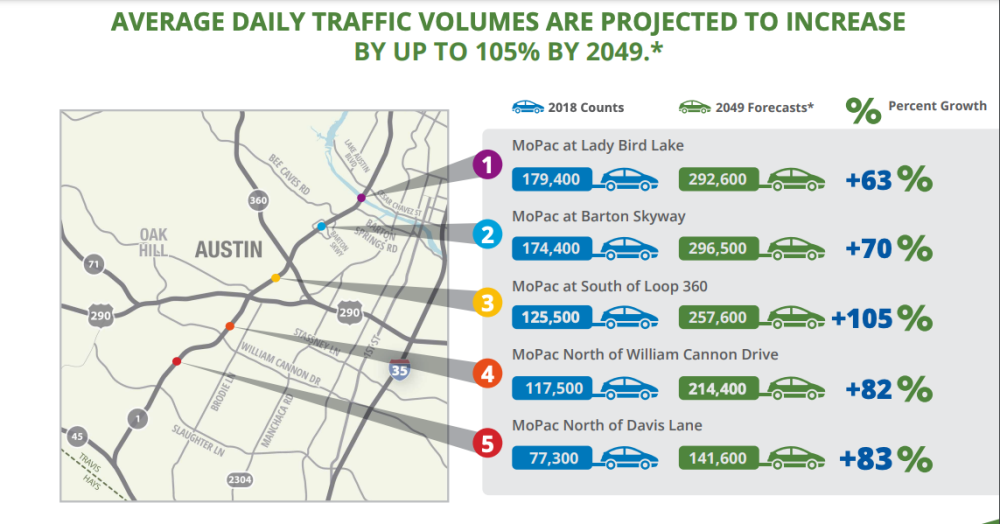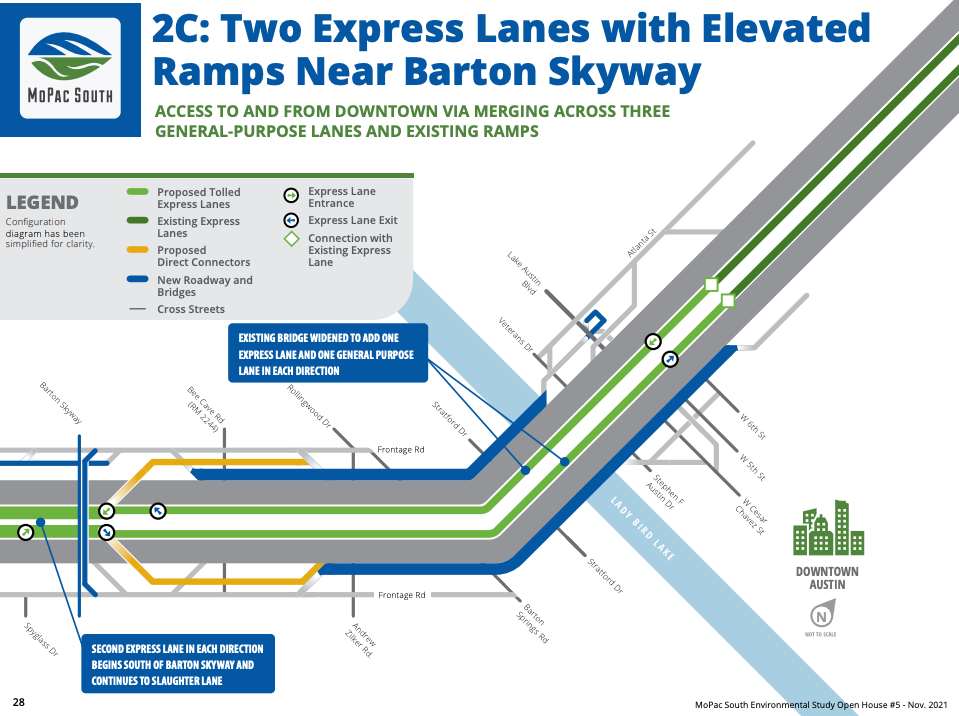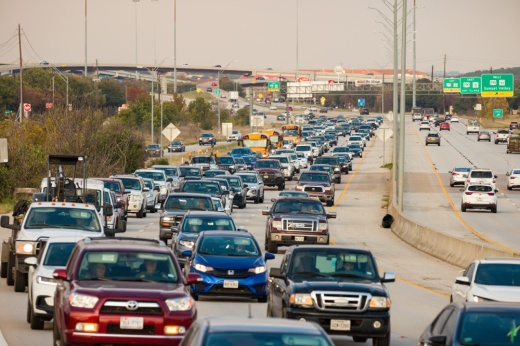What you need to know
After receiving the initial green light in 2013 to evaluate an 8-mile stretch of south MoPac from Cesar Chavez Street to Slaughter Lane, transportation officials are again presenting several proposed solutions for public review after a lawsuit stalled progress on the project from 2016 to 2021.
The agency has dialed in on plans for up to two new toll lanes in either direction.
The next public open house will be Nov. 12 and hosted by both the Mobility Authority and the Texas Department of Transportation, or TxDOT. The virtual component of the open house will remain open from Nov. 12 to Dec. 29.
Some context
MoPac is ranked among the top 20 most congested corridors in the state, according to the Texas A&M Transportation Institute.
This section of MoPac plays a vital role in connecting parts of South Austin and Hays County to key highways, such as Loop 360 and Hwy. 290, as well as providing access to downtown Austin, according to an overview of the project.
TxDOT’s traffic data from 2023 indicates that this stretch of highway handles up to 200,000 vehicles daily, a news release states. Transportation authorities are pointing to ongoing population growth and expanding residential and commercial developments for the worsening traffic congestion.

In 2013, the Mobility Authority partnered with TxDOT, conducting an Environmental Study of the south MoPac corridor to determine the best alternatives for improving mobility and safety.
The study evaluated a range of improvements:
- Adding new lanes for general use in each direction
- Constructing high-occupancy vehicle, or HOV, lanes in each directions
- Building transit-only lanes in each direction
- Adding express lanes in each direction
- Using transportation systems and demand management services
"The express lanes perform the best," Charlotte Gilpin, a Mobility Authority consultant working on the project, told Travis County Commissioners during an update on the project in May.
The agency is now evaluating the best configuration, considering several options:
- One express lane with a downtown exit
- One express lane without a downtown exit
- Two express lanes with a downtown exit
- Two express lanes without a downtown exit
- Two express lanes with elevated ramps near Barton Skyway
- City of Austin proposal
Gilpin indicated the agency is leaning toward two express lanes in either direction with elevated ramps near Barton Skyway.

After having participated in a community outreach event with the agency earlier this year, Bobby Levinski, a lawyer for the Save Our Springs Alliance, wrote a letter to the Mobility Authority on June 26. He voiced concerns for the environmental impact to the water quality of Barton Springs, a result of highway water runoff and groundwater contamination, as well as its impact to endangered species in the area and a disruption to wildlife throughout the construction process.
“[Save Our Springs Alliance] will be mounting a campaign against the project and encouraging transportation policy makers to reconsider alternatives,” Levinski wrote in an email to Community Impact on Oct. 30.
Levinski added that the express lanes would primarily benefit those who can afford daily toll fees, the “wealthiest of commuters,” noting that the average Austin commuter and nontoll users would see only “nominal” improvements.
Another active participant in the project’s community engagement, the city of Rollingwood Mayor Gavin Massingill also reached out to the Mobility Authority this summer.
He wrote in a letter July 12 his concern with the fact that the agency had not updated the project materials, schematics, cost estimates and traffic projections since originally developed in 2015.
“The impacts to future travel times are estimated to be much less,” Massingill wrote, referring to the most recent 2045 traffic projections by the region's transportation planning agency, Capital Area Metropolitan Planning Organization.
Travis County Commissioner Brigid Shea questioned whether the agency has incorporated any of the “thousands of public comments” into design plans for the double-decker bridge crossing Lady Bird Lake.
“Here's where it gets, frankly, messy and confusing,” Shea told Mobility Authority staff during their update. “... We never got a clear explanation of how those comments were taken into consideration in the process. ... And I still don't have any idea what the proposal is for the design of the river crossing.”
The outlook
Mobility Authority Executive Director James Bass told commissioners that the agency has updated their plans with the 2045 traffic forecast data, which can be found on the project website.
Gilpin also assured commissioners that the public feedback was “absolutely heard.” She said the agency has incorporated other options for review by the public.
After reviewing public input during this latest open house, Mobility Authority documents anticipate construction to begin in 2025. Mobility Authority staff is hoping to select one of the configurations by end of 2024, Bass said.
Find more information on the agency’s proposed configurations, noise and traffic abatement plans, and more at www.mopacsouth.com.
One last thing
The toll agency has faced criticism for its claims about the amount of time commuters save by the construction of an express lane.
Regional traffic studies indicate that there is only a roughly five-minute difference in travel time should nothing be done to the current structure of the highway, called the no-build option.
According to Bass, in 2022 commuters traveling northbound from Slaughter Lane to Cesar Chavez Street took an estimated 14 minutes. The 2045 traffic model forecast the trip now taking 20 minutes—so an additional six minutes.
In 2022, southbound travel along the same 8-mile stretch took roughly 17 minutes during peak hours, and in 2045 traffic is projected to take 22 minutes—an additional five minutes.
However, Bass said with the build-out of express lanes, northbound general traffic lanes would only increase by one minute, and those using the express lane could make the 8-mile stretch in eight minutes.
Southbound traffic will remain the same 17 minutes in the general-use lanes, Bass said, with those using the express lane making the commute in eight minutes.





